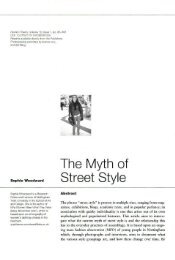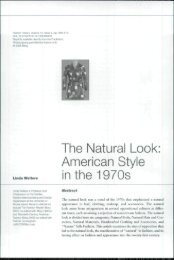Spinning the Ephemeral PDF - SMU Fashion Media
Spinning the Ephemeral PDF - SMU Fashion Media
Spinning the Ephemeral PDF - SMU Fashion Media
Create successful ePaper yourself
Turn your PDF publications into a flip-book with our unique Google optimized e-Paper software.
286 Fiona Anderson<br />
Figure 2<br />
A group of four MPs outside<br />
<strong>the</strong> House of Commons,<br />
London, 1860. George Weld<br />
(1807-86). Conservative MP is<br />
wearing a pair of trousers in<br />
<strong>the</strong> shepherd's check.<br />
Courtesy of <strong>the</strong> National<br />
Portrait Gallery, London.<br />
quality of manufacture (Textile Manufacturer January 15 1878: 2). A<br />
Ha wick manufacturer quoted in a local newspaper of October 27 1855<br />
stressed this emphasis of <strong>the</strong> Scotch tweed trade when he encouraged o<strong>the</strong>r<br />
manufacturers to "Spare no expense on your wools . . . your dyestuffs<br />
. . . aim at excellency of fabrics . . . and beauty of design; repel every<br />
attempt to compromise" {Hawick Advertiser October 27 1855). Interestingly<br />
for a branch of <strong>the</strong> nmeteenth century textile industry renowned<br />
for <strong>the</strong> production of constant novelty and variety in design, <strong>the</strong> bulk of<br />
<strong>the</strong>ir cloth was designed for menswear (Ponting 1987: 84-7; Taylor 1999:<br />
42-3).<br />
In order to explore <strong>the</strong> <strong>the</strong>oretical issues dealt with in this article, it is<br />
important first to clarify <strong>the</strong> type of cloths that came under <strong>the</strong> generic<br />
name of tweed in <strong>the</strong> late nineteenth century. James Locke is linked to<br />
<strong>the</strong> mythology surrounding <strong>the</strong> origins of <strong>the</strong> name tweed in that various<br />
texts debate whe<strong>the</strong>r <strong>the</strong> word derived from a clerk working for Locke<br />
who misread <strong>the</strong> Scottish word tweel or twill (which was <strong>the</strong> weave<br />
characteristic of Scottish woolens at that time) for tweed, or if <strong>the</strong> name<br />
derives from <strong>the</strong> Tweed river in <strong>the</strong> Scottish Borders (Ponting 1987: 83;<br />
Stiliie 1970: 311). What is more conclusive as evidence is that <strong>the</strong> word<br />
tweed does not appear in any business data surveyed before <strong>the</strong> early<br />
1840s and that it was widely used after that throughout <strong>the</strong> textile and




